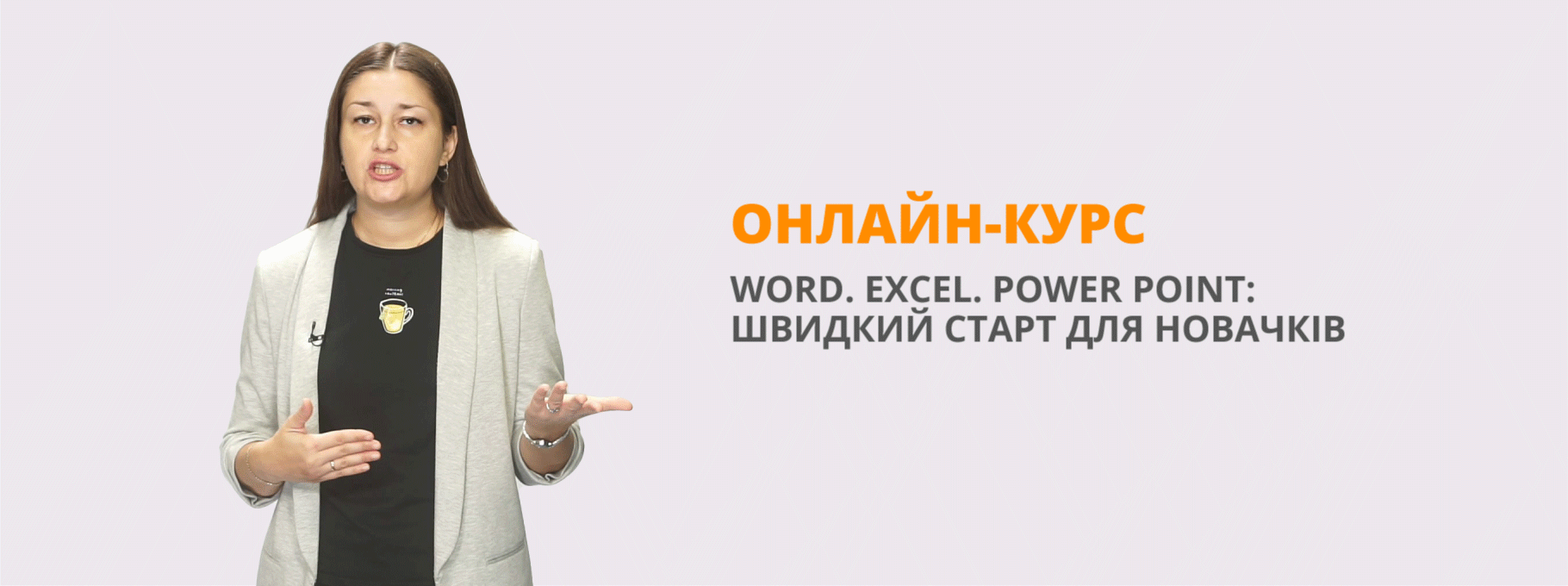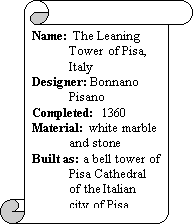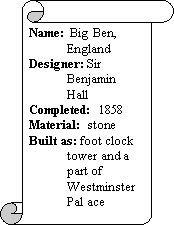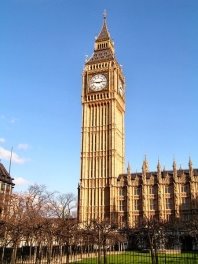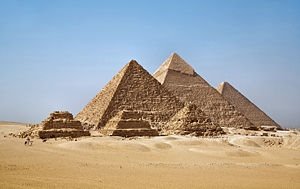Визначні місця світу
A WORLD OF WONDERS
The Teaching Aims:
- To activate the lexical material on the topic;
- To practise the use of the Passive Voice;
- To develop listening and reading skills;
- To improve speaking skills;
The Developing Aims:
- To develop the students’ attention, memory and logical way of thinking;
- To promote the students’ curiosity;
- To motivate the students’ spontaneous speech;
The Upbringing Aims:
- To stimulate the students’ thinking and discussion;
- To provide the students with the information about the world sights;
- To motivate the students to learn more about the world of wonders and other landmarks;
Equipment and visual aids:
- Pictures of the world landmarks;
- Handout material;
- Tape – recorder;
- The map of the World
Procedure of the Lesson:
- Preliminaries of the Lesson.
Greeting. Reporting objectives.
T: Good morning, children. I’m glad to see you.
P: Good morning, dear teacher. We are glad to see you too.
T: You may take your seats.
T: The subject of our lesson is…..
- Introduction.
(Mobile phone rings)
T: - I’m sorry my dear friends. Hello! Is that you, Helen? Glad to hear you.
- What? Vacations? That’s great!
- Don’t know where to leave for?
- Will you come to my lesson tomorrow? My students will tell you how to spend the time in the best way.
- Deal. Bye, see you soon.
T: - As you heard, children, my friend Helen is having her vacations and she is planning to spend pleasant time. However, Helen hasn’t decided yet where to go. So, I have decided her to visit our lesson. I am sure we will give her a piece of advice to have a pleasurable experience. Thus, we must be ready. Now, look at the blackboard and try to guess the subject of our lesson.
P: - World of wonders, world’s places of interest.
T: - That’s right. Today we are talking about the most attractive places of the world. We’ll try to persuade Helen to spend her holidays in the exciting places of the world to get unforgettable experience of her life.
- Warming up activity.
Brainstorm the ideas.
T: - First of all I’d like to know if you like travelling, children.
P:-Yes, we do.
T:-So, do I. It’s unbelievably interesting thing at any age and in any season.
I guess some of you have already been in many cities not only of Ukraine but in other countries as well. I’m sure you’ll have an opportunity to set on an unforgettable tour all over the world on your holidays, won’t you?
P:-Yes, certainly.
T:-So, children, while learning the theme you knew a lot about the world of sights: ancient, modern, medieval and so on. Let’s refresh them all from your memory.
So, try to relax. Close your eyes and think of a world’s sight you would like to visit the most. Open the eyes. Please, come up to the teacher’s desk and take the landmark you imagined. Now name it and stick it on the world’s map
related to its location. For example: The Eiffel Tower, France)
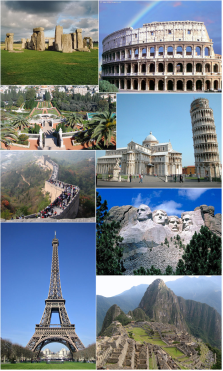 The Wonders list:
The Wonders list:
The Great Pyramids of Giza, Egypt
The Great Wall of China, China
Taj Mahal, India
The Colosseum, Italy
The Stonehenge, England
Big Ben, England
The Golden Gate Bridge, the USA
The Statue of Liberty, the USA
The Leaning Tower of Pisa, Italy
The Eiffel Tower, France
Mount Rushmore National Memorial, the USA
Machu Picchu, Peru

T: That’s great! Now I see you know which country of the world each of the landmarks is situated in.
Task.2
T: - I wonder, children, if you can guess the place of interest. Describe the sightseeing you want. Try not to call it. Come up to the blackboard and show it.
P1: - This landmark is located in Peru. (the correct answer ) Its name means “old peak” in English. It was a royal period. It used to be a religious place for the purposes of prayer or meditation. Have you guessed what it is?
P2: - It is Machu Picchu. (the correct answer) This sight is in England. It was built of circular setting of large standing stones and served as an ancient observatory.
P3:- It’s Stonehenge. (the correct answer) The next landmark is in Rome, Italy and has the form of amphitheatre.
P4:-I think you described the Coliseum. (the correct answer) I’m sure you all know the next sightseeing very good. It is the 316 foot clock tower named after Sir Benjamin Hall. This clock is the part of Westminster Palace or the Houses of Parliament.
P5:- It’s the world’s well known sight. It’s Big Ben. (the correct answer) The following place of interest is devoted to the four American Presidents. Haven’t you guessed yet?
P6: -I know. That is Mount Rushmore National Memorial. (the correct answer) This striking technical work links San Francisco, California and Marin County.
P7: -All will be fascinated by the beauty of the Golden Gate Bridge.
T: - So, children, I see you can describe and recognize the places of interest we have been learning for many lessons.
Main part of the lesson.
Practicing the using of the Passive Voice. Developing dialogical speech.
Pair work.
Pre- reading activity.
T: - Well, now, I’d like to suggest you to check up yourselves if you are ready to answer Helen’s questions. Let’s imagine that one of your pair is Helen. Give her the information about each of the landmarks she is interested in.
Task1. Skim the information in the notes; read the example dialogue to yourself. Focus your attention on using and forming the Passive Voice. Remind me, please.
P: We use the Passive Voice when the action is more important than the agent. We usually omit the agent if it is a word such as they or someone, but keep it if it has some importance in the sentence.
(the pupils are given the handouts)
Post-reading activity.
Task.2 Make up and act the similar dialogues out in pairs.
- Where is the Eiffel Tower
- located?
- It is located in Paris, France.
-
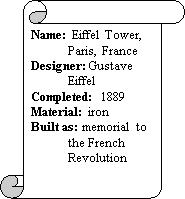 Who was it designed by?
Who was it designed by?
-
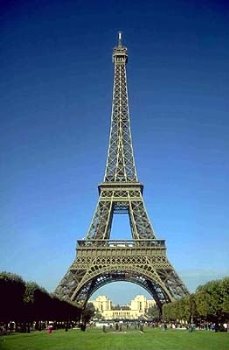 It was designed by Gustave Eiffel.
It was designed by Gustave Eiffel.
- When was it completed?
- It was completed in 1889.
- What is it made of?
- It is made of iron.
- Why was it built?
- It was built as a memorial to the French Revolution.
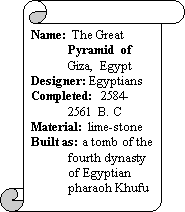
T:Thank you, pupils. You managed with this kind of work and put the verbs into the correct Passive tense.
- Developing listening and speaking skills.
Pre-listening activity.
Task1. Now pupils, we are talking about well – known site. It is in New York and symbolizes the Independence of the United States. Have you guessed what attraction it is? (the pupils say that it is the Statue of Liberty). Look at the blackboard, repeat after the teacher the following words in better learning. Listen to the eliciting of the meaning of them. Give the appropriate equivalents to the definitions.
Key-words:
torch – a lamp, a lantern;
copper – a red-brown metal;
reassemble – put smth. together again;
admire – to look at with pleasure;
steel – a hard, strong grey of iron;
iron – a strong, hard silvery-grey metal;
support – a thing that keeps it upright;
Task2. Make up the sentences, using the new words.
T: Well done work. I see that you all know the meaning of the new words. They will help you to understand the text about the Statue of Liberty.
While-listening activity.
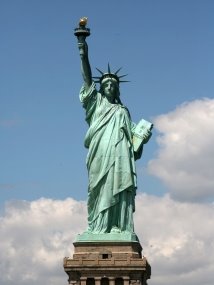 Task3. Listen to the cassette and cross out the inappropriate words.
Task3. Listen to the cassette and cross out the inappropriate words.
Name/Place/Description.
- Statue of Liberty in New York
- huge statue of woman holding tablet in left hand and light/torch in right hand
- seven points of her crown/hat represent the seven oceans and continents of world
Historical Facts
- designed by Frederic-Auguste Bartholdi
- was started in 1876 — was finished in 1884
- made of copper with steel/iron supports
- gift to Americans from Finns/French to celebrate the 100th anniversary of American Declaration of Independence
- statue was made in sections: June/July 1885 put into 214 boxes and shipped to New York - reassembled in four weeks/ months
- declared national monument in 1924
- climb 354 steps to reach the crown, admire the view from 25 balconies/windows
- visit the Statue of Liberty exhibit (museum objects, photographs, prints, videos)
Recommendation
• amazed by statue - not to be missed
Post-listening activity.
Task4. Ask and answer rolling questions about the Statue of Liberty to find out special information.
(developing dialogical speech)
P1: - Where is the Statue of Liberty?
P2:-In New York. What does it look like?
P3:- It’s a statue of a woman holding a tablet in her left hand and a torch in her right hand. What do the points on her crown represent?
P4:- The seven oceans and continents of the world. Who was it designed by?
P5:- It was designed by Frederic-Auguste Bartholdi. What is it made of?
P6:-It is made of copper with steel supports. Why was it gifted to the Americans from the French?
P7:- It was a gift to celebrate the 100th anniversary of American Declaration of Independence. It was shipped to New York in 1885 in sections, wasn’t it?
P8:- Yes, it was. Was it reassembled in a month?
P9:- No, it wasn’t. It was reassembled in four months. How many steps can you climb to reach the crown?
P10:-You can climb 354 steps to reach the crown and admire the view from 25 windows. Will any visitor be amazed by this beautiful statue?
P11:- Yes, surely will.
T: - Dear children, I see you know much about the popular landmark of the USA. Now tell about the Statue of Liberty.
Task5. Tell about the Statue of Liberty.
(developing monological speech)
The Statue of Liberty in New York is a huge statue of a woman holding a tablet in her left hand and a torch in her right. She wears a crown with seven points, which represent the seven oceans and continents of the world.
The Statue of Liberty was designed by Frederic-Auguste Bartholdi. It was started in 1876 and was finished in 1884. It is a gift to the Americans from the French, to celebrate the 100th anniversary of American Independence. The statue was made in sections. In June 1885, it was put into 214 boxes and shipped to New York. It was reassembled in four months. The statue was declared a national monument in 1924.
Nowadays, people can climb 354 steps to reach the crown, and admire the view from twenty-five windows. They can also visit the Statue of Liberty exhibit, which has museum objects, photographs, prints and videos.
- Improving speaking skills.
Project work.
Task. Tell about a famous landmark you would advise Helen to visit during her vacations. (the pupils talk about world of wonders, using the pictures)
7. Making conclusion.
Today we have travelled all around the world and we have seen a lot of world’s wonders we have already learnt. I am sure you will recommend Helen the landmarks which are worth seeing and for spending her vacations in a best way. We have done lots of exercises in which you were developing your listening, reading and speaking skills. You were active and I am satisfied with your answers indeed. However, some you made some mistakes. So, I’d like you to revise the using and forming the Active and Passive Voice; the structure of the English sentence; using Articles and prepositions; focus your attention on pronunciation of Proper Names. So, your marks for today………
8. Homework. Compose and write down the route with full information for tourists about the world’s wonders.
9. Filling “Student Self Assessment Checklist”.
T: Now, I’ d like to know how you can evaluate your own activity at the lesson.
Please, fill in the following student self assessment checklist. Tick – excellent-very well-ok-not very well-poor - to evaluate your own work at the lesson. I analyze your opinion and take into account. We will discuss them next lesson. So, the time is up. You may be free. See you tomorrow, children. Good bye.


про публікацію авторської розробки
Додати розробку
